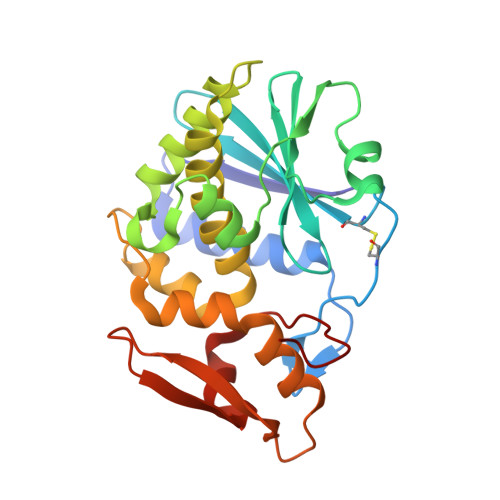A new activity of anti-HIV and anti-tumor protein GAP31: DNA adenosine glycosidase--structural and modeling insight into its functions.
Li, H.G., Huang, P.L., Zhang, D., Sun, Y., Chen, H.C., Zhang, J., Huang, P.L., Kong, X.P., Lee-Huang, S.(2010) Biochem Biophys Res Commun 391: 340-345
- PubMed: 19913503
- DOI: https://doi.org/10.1016/j.bbrc.2009.11.060
- Primary Citation of Related Structures:
3KTZ, 3KU0 - PubMed Abstract:
We report here the high-resolution atomic structures of GAP31 crystallized in the presence of HIV-LTR DNA oligonucleotides systematically designed to examine the adenosine glycosidase activity of this anti-HIV and anti-tumor plant protein. Structural analysis and molecular modeling lead to several novel findings. First, adenine is bound at the active site in the crystal structures of GAP31 to HIV-LTR duplex DNA with 5' overhanging adenosine ends, such as the 3'-processed HIV-LTR DNA but not to DNA duplex with blunt ends. Second, the active site pocket of GAP31 is ideally suited to accommodate the 5' overhanging adenosine of the 3'-processed HIV-LTR DNA and the active site residues are positioned to perform the adenosine glycosidase activity. Third, GAP31 also removes the 5'-end adenine from single-stranded HIV-LTR DNA oligonucleotide as well as any exposed adenosine, including that of single nucleotide dAMP but not from AMP. Fourth, GAP31 does not de-purinate guanosine from di-nucleotide GT. These results suggest that GAP31 has DNA adenosine glycosidase activity against accessible adenosine. This activity is distinct from the generally known RNA N-glycosidase activity toward the 28S rRNA. It may be an alternative function that contributes to the antiviral and anti-tumor activities of GAP31. These results provide molecular insights consistent with the anti-HIV mechanisms of GAP31 in its inhibition on the integration of viral DNA into the host genome by HIV-integrase as well as irreversible topological relaxation of the supercoiled viral DNA.
- Department of Biochemistry, New York University School of Medicine, New York, NY 10016, USA.
Organizational Affiliation:

















